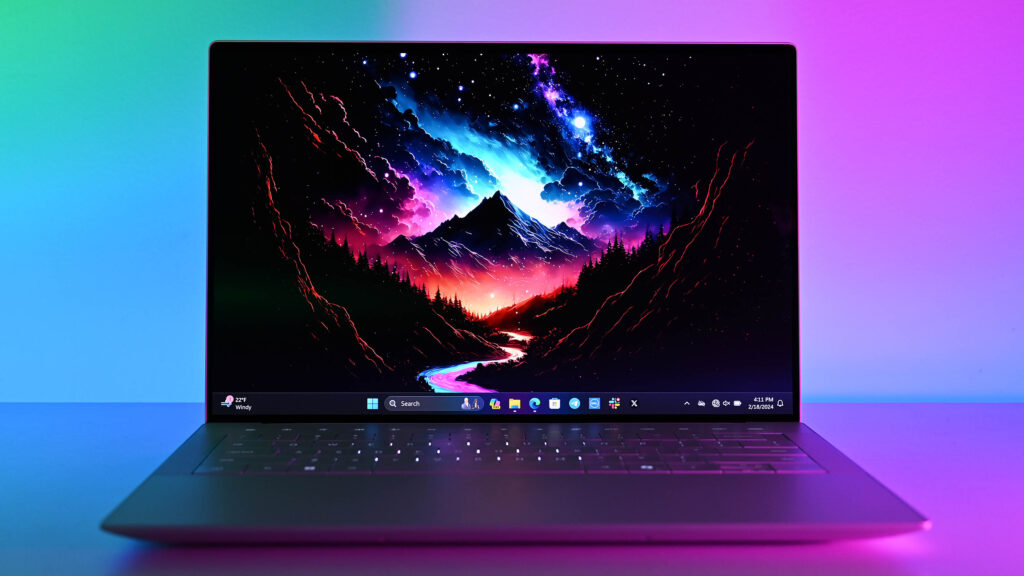Table of Contents

Introduction: Best AI-Assisted Power Management Laptops 2025
Best AI-Assisted power management laptops 2025 has always been a top purchase criterion for laptop buyers. In 2025 the battleground shifted: rather than only larger batteries or more efficient silicon, laptop makers now combine on-device AI NPUs and power-aware algorithms, smarter power-delivery hardware (PMICs), and OS-level intelligence to adapt performance and power dynamically to your behaviour. The result: laptops that preserve longer battery life without forcing you to compromise user experience and machines that intelligently balance thermals, fan noise, and performance in real time. This article explains how AI-assisted power management works, why it’s important, highlights real vendor implementations, and gives practical buying and usage advice so you pick the best laptop for your needs.
1. What is AI-assisted Power Management?
At its core, AI-assisted power management is an extra layer of intelligence that sits between hardware and software and actively predicts and schedules power delivery. Traditional power saving used static thresholds e.g., lower CPU clock below X% battery, reduce screen brightness at idle. AI-assisted systems:
- Observe usage patterns: App foreground/background habits, typing vs media playback, connectivity needs.
- Predict short-term load: Decide whether bursty performance will be needed in the next few seconds/minutes.
- Adjust power rails and clocks proactively: Scale CPU/GPU/NPU, tweak voltage, shift tasks to more efficient cores, and tune display backlight.
- Control charging behavior: Slow or adaptive charging to reduce battery aging when appropriate.
- Learn on device: Keep local models that adapt to your style work vs media vs meetings rather than relying only on cloud heuristics.
2. Why now? (The Convergence That Made AI Power Practical)
Several trends converged to make AI power management mainstream to this best AI-Assisted power management laptops 2025:
- NPUs are standard in consumer chips. Processor families (the “AI PC” push) now include dedicated AI engines capable of real-time inference at milliwatt power levels enabling always-on predictive models.
- OS ecosystems added APIs and frameworks. Microsoft and Apple introduced APIs and integrated services (Copilot+ initiatives, power telemetries) so vendor software can safely modulate performance and power states.
- Smarter PMICs and integrated power designs. New PMICs provide more granular control and faster transitions between power states, which the AI models exploit to avoid overshoots or thermal spikes.
- Expectations changed. Users expect AI features and longer real life battery from thin laptops OEMs responded by baking intelligence into power control rather than just increasing battery capacity.
3. How the Tech Actually Works
3.1 Observability – Sensors and Telemetry
AI systems ingest a wide array of signals for this best AI-Assisted power management laptops 2025:
- CPU/GPU utilization, per-core clock frequencies
- Battery voltage, state of charge, temperature sensors
- Screen brightness and ambient light sensor
- Keyboard/mouse activity, microphone/webcam usage
- App context (video call, local editing, streaming, gaming)
This telemetry is normalized and sent to a tiny on-device model for prediction.
3.2 Prediction – What Happens Next?
Models predict short-term demand (5–60 seconds) and medium-term patterns (minutes/hours). Example predictions:
- “User is likely to watch a 20-minute video” → hold a higher display brightness but lower CPU boost.
- “User is typing and will compile code” → pre-alloc high CPU short bursts but keep GPU power low.
The NPU runs these models with minimal energy overhead, so the net saving is positive.
3.3 Enforcement – Making Changes Safely
Predictions translate into actions:
- Smooth CPU/GPU frequency transitions avoid spikes that waste energy.
- Move background AI tasks to an energy-efficient core or the NPU.
- Reduce display PWM frequency and backlight when reading or when face detection says user is not looking.
- Adjust fan curves proactively to prevent thermal escalation rather than reacting to a high temperature.
Firmware/OS enforce safe boundaries the AI can nudge settings but cannot crash the system.
3.4 Battery Health & Charging Intelligence
AI can manage charging behavior for longevity to this best AI-Assisted power management laptops 2025:
- Adaptive charging: slow down when user routinely leaves laptop plugged in overnight.
- Temperature-aware charging: reduce charge rate when battery temp is high.
- Cycle management: limit full-charge windows to reduce chemical aging.
Apple’s battery health management is an example of OS-level longevity features; AI simply makes these strategies smarter and more personalized.
4. Real Benefits You Will Notice
When implemented well, AI power management gives concrete benefits:
- Longer daily runtime (real-world): Not just lab figures, users often see 10–30% longer battery life for mixed workloads web browsing, streaming, document work. This is achieved by avoiding wasteful spikes and trimming unneeded background power.
- Fewer thermal throttles: Predictive fan and voltage control prevents sudden thermal climbs, which keeps sustained performance higher in long tasks.
- Quieter operation: Because the system avoids catching up with heat after spikes, fans run at lower, steadier levels most of the time.
- Healthier battery over years: Adaptive charging and better thermal control slow chemical aging. Apple’s battery health features show the value of software-level battery longevity measures, adding AI personalization enhances them.
5. Vendor Approaches & Notable Implementations
Below are vendor examples that combine hardware and software to deliver AI power benefits for the best AI-Assisted power management laptops 2025.
Intel – Dynamic Tuning Technology & Adaptix
Intel provides Adaptive/ Dynamic Tuning frameworks (DTT) that OEMs use to map system events to power policies, and their AI/Adaptix toolset helps tune battery, thermal and performance profiles. These frameworks allow OEMs to deploy machine-learned policies across CPU, GPU, and integrated NPUs. Intel cautions against disabling these components because they integrate many safety and performance rules.
Microsoft & Copilot+ / Windows AI Features
Microsoft’s AI PC initiative and Windows updates include background intelligence to optimize battery and runtime for Copilot and other local AI tasks. Windows exposes APIs to let OEMs and Microsoft services adapt power profiles, enabling better battery behavior in thin machines running AI tasks to the best AI-Assisted power management laptops 2025.
Apple – Battery Health Management + Ecosystem
Apple’s approach focuses on battery longevity via features that learn charging patterns, temperature exposure, and adapt charging behavior. While Apple historically used software heuristics, the trend is moving toward more intelligent on-device prediction and scheduling to further protect battery health.
OEMs – Lenovo, Dell, Samsung, Dynabook, LG
Many laptop makers now market AI PC lines:
- Lenovo collaborated closely with Intel on AI features and branded Aura/Aura Edition AI PCs claiming best-in-class battery life through integrated tuning and AI agents.
- Dell explicitly positions “AI PCs” that use adaptive power management to extend runtime for typical users.
- Dynabook and other business OEMs reference AI battery management as a feature in models aimed at enterprise users.
- LG (Gram) focuses on integrated AI platforms that combine on-device inference with cloud services and advertise very long playback hours real-world battery claims, enabled by tight hardware/software co-design.
6. How to Pick the Best AI-Assisted Power Management Laptop
Not all AI marketing is equal. Use this checklist to separate real tech from buzz:
- Look for an on-device NPU + clear software stack
- An explicit NPU or AI accelerator on the spec sheet and OEM software that references AI power or battery intelligence indicates genuine capability.
- Vendor collaboration with silicon partners (Intel/AMD/Qualcomm/Apple)
- Real implementations are often joint efforts (e.g., Intel + Lenovo) because tuning requires firmware, driver, and OS coordination.
- Readable performance & battery tests
- Do not rely on manufacturer numbers alone, seek third-party reviews that report mixed workload runtime and sustained performance long render or compile tests. Windows Central, PC World and other outlets test these.
- Customizable OEM power modes
- The best systems let you tune aggressive/efficient presets or choose automatic AI mode. If the AI mode is a single opaque toggle with no results, treat cautiously.
- Battery longevity features
- Look for “adaptive charging,” “battery health management,” or explicit battery aging prevention features integrated with AI.
- Real-world comfort
- Check thermals and fan noise in sustained loads (10–60 minute tests) AI power management should reduce abrupt spikes.

7. Real World Scenarios & Recommended Picks
Below are typical users and what to prioritize.
For Writers, Students & Remote Workers (All-Day Battery)
- Priority: long standby, excellent mixed-use battery life, quiet fans.
- Recommended features: NPU + OS AI mode, adaptive charging. Look at ultraportable AI PC options from ASUS/Lenovo/HP and Apple MacBooks with Apple’s longevity stack.
For Creators (Photo/Video Editing)
- Priority: burst performance, minimal throttling during long exports, good battery when not exporting.
- Recommended: laptops that can predict heavy export tasks and pre-stage cooling models built on Intel DTT or similar OEM stacks usually do better on sustained loads.
For Business Fleets: IT-Managed Laptops
- Priority: Battery longevity, predictable charging policies, security.
- Recommended: Enterprise models with vendor-controlled power profiles Dynabook, Lenovo business AI models and server-side management integration.
For Gamers
- Priority: Peak performance, but intelligent transient power management to avoid wasted power between sessions.
- Recommended: Gaming laptops with hybrid modes and explicit AI tuning that reassigns tasks to efficient engines when full GPU power is not needed. Real gains vary by vendor.
8. Benchmarks & How to Test a Laptop Yourself
If you want to validate AI power claims for this best AI-Assisted power management laptops 2025:
- Mixed-use loop realistic day:
- Run a 3-hour loop: 1 hour of browsing + doc editing (light), 30 minutes video streaming, 60 minutes video playback, 30 minutes video export. Measure starting and ending battery percent and runtime. Compare AI mode vs. non-AI mode.
- Sustained export test:
- Run a 60-minute CPU/GPU render. Measure sustained frequencies and thermal/clock behavior. See if the laptop sustains higher clocks for longer with AI on.
- Idle & standby test:
- Charge to 100%, leave idle for 24 hours screen off. AI systems that reduce background waste will show lower standby drain.
- Charging & battery health:
- Check if the laptop offers adaptive charging and how long a full charge takes check battery-health features in settings.
9. Privacy, Security & Trust
- Where are models run? Prefer on-device inference. Local models avoid constant telemetry to cloud and preserve privacy.
- What telemetry is collected? Vendors should disclose what signals are used system efficiency, not content. Verify privacy docs.
- Can you opt out? Good vendors allow toggling AI power mode and data sharing preferences.
- Firmware safety: AI must operate within firmware/OS safety bounds to avoid instability look for vendor support and driver update policies.
10. Limitations & What AI Power Won’t Do
- AI can not create energy it only reduces waste and manages tradeoffs. Expect improvements (10–30% in many mixed cases), not orders of magnitude change.
- Poor hardware design tiny battery, bad thermals cannot be fully fixed by software. Good AI multiplies well-designed hardware, it cannot compensate for fundamentally poor components.
- Early implementations may be buggy or overly aggressive check user forums for real experience with a model before buying.
Frequent Ask Questions (FAQs)
Generally people asks the question related to this best AI-Assisted power management laptops 2025:
Q: Do AI PCs actually extend battery life?
A: Yes in many mixed-workload tests AI power management results in noticeably longer runtime because it trims wasteful power spikes and optimizes charging. Expect real-world improvements of 10–30% depending on workload and implementation.
Q: Are NPUs necessary for AI power management?
A: NPUs make on-device inference efficient, but some vendor stacks use efficient CPU/GPU microcontrollers and clever heuristics. For best energy efficiency, an NPU or dedicated low-power accelerator helps.
Q: Will AI features drain battery running 24/7?
A: No these models are designed to run at milliwatt scale. The energy they use is typically much less than the savings they generate. However, how well this holds depends on implementation.
Q: Can I disable AI power management?
A: Most vendors provide toggles or modes. If you prefer manual control you can usually switch to a fixed performance profile. However, disabling vendor tuning can sometimes lead to suboptimal thermals or battery behaviour.
Conclusion: The Future of Battery Intelligence
AI-assisted power management in 2025 matured from an R&D idea into a practical feature set present on many laptops. It’s not magic it’s the smart use of sensors, NPUs, PMICs and OS integration to predict demand, eliminate waste, and preserve battery lifespan. For buyers, the advice is simple: pick laptops with transparent, on-device AI stacks, read third-party mixed-workload tests, and prefer vendors that actively refine power policies via firmware updates. The result is better battery life, quieter fans, and fewer unpleasant thermal surprises exactly what modern mobile users want for this best AI-Assisted power management laptops 2025.


1 thought on “Best AI-Assisted Power Management Laptops 2025”